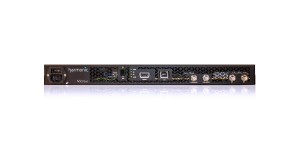Tech companies take positions for next-generation broadband
The timing and nature of the rollout of sophisticated CMTS-type equipment at the edge of cable and other fixed networks has emerged as one of the key talking points of this year’s ANGA COM expo in Cologne, as vendors adopt various positions in preparation for the adoption of next-generation broadband technologies by MSOs.
Harmonic used the show to launch it NSG Exo distributed CCAP device, which the technology vendor claims will set it apart from rival providers in the space as it combines remote PHY and MAC layers – respectively the layer of a system that handles the physical transmission of data, and the media access controller that handles its generation – in a single device that sits at the edge of the network.
David Whitehead, director of pre-sales and technical services at Harmonic, described the NSG Exo as “a small form-factor CMTS…for multiple dwelling units (MDUs) that have existing in-building coax”.
“It’s a very simple way of doing doing data and voice over that infrastructure,” he said.
Whitehead said Harmonic’s product primarily targets telcos looking to deliver services to the MDU market, while cable operators “do not typically address those MDUs very well or they already have a solution”, he said.
The technology is designed to enable service providers, including telcos, to rollout DOCSIS-based data services to the MDU market with a device that sits at the end of their fibre plant, typically in the basement of the apartment building, and enables the provider to deliver services to individual homes via existing in-building coax. According to Harmonic it could also be suitable for cable operators that have yet to roll out DOCSIS 3.0 services and have not yet invested in DOCSIS 3.0 headends.
“Today it’s for voice and data although we have built additional capabilities into the box to do IP video – that is on the roadmap of future functionality,” said Whitehead. The indoor version of the product will be commercially available in the third quarter of this year, he said.
“The distributed architecture approach to CCAP puts different pieces of the functionality in different places. This is directly in line with our larger CCAP solutions – there is nothing proprietary,” said Whitehead. He contrasted this with solutions that split the MAC and PHY layers, most typically by deploying a remote PHY device and retaining the MAC layer at the headend. “With the MAC at a different location you have to do the [communication between the two] in a proprietary way,” he said.
Other technology vendors have deployed remote PHY products ahead of a fully remote CCAP architecture becoming standard.
At ANGA COM, technology provider Teleste announced a tie-up with CCAP-compliant CMTS vendor Casa Systems to deploy a remote PHY-based next-generation access system.
Hanno Narjus, senior vice-president, video and broadband solutions, Teleste, said that Casa Systems would upgrade its CMTS to support a remote PHY architecture while Teleste would provide QAM and OFDM modulators in the optical node at the edge of the network.
“We need the protocols in place to ensure that the Casa back office works with our remote PHY solution,” he said.
Narjus said he believed the solution would meet CableLabs standards, even though the communication between MAC and PHY layers of a distributed system has yet to be fully standardised. “We are confident a standard will be produced. We believe that we can launch these solutions with the best time to market, and we are working parallel to the standards development,” he said.
Large market
Narjus said Teleste and Casa Systems expect to have a proof of concept in place by the end of this year and that he did not not believe there would be deployments of the technology ahead of standards being in place. However, he said Teleste wants to be in a position where it can deliver products to the market quickly once the standard is set.
Narjus said that the main difference between distributed CCAP and remote PHY is that with the latter the cable modem control functionality resides in the CMTS.
“We don’t take sides on remote PHY versus distributed CCAP. But for major MSOs the likelihood is they will adopt remote PHY because they have got legacy CMTS systems in place, and they want to keep as much as possible in the central office,” he said. “Distributed CCAP is more viable for greenfield operators or telcos that don’t have the legacy CMTS infrastructure. For major MSOs, remote PHY will be the next evolutionary step.”
Narjus said that Teleste could support both architectures. “There are different segments and markets and we can serve both telcos and cable segments as well as both established and developing markets,” he said.
Narjus believes the potential market for such solutions is very large. He points out that millions of MDUs across Europe have coax inside that is typically used to deliver a communal satellite or terrestrial signal to homes but is not connected to a network. There is also a large potential market in the hospitality sector, he said.
Arris, a major CMTS vendor, is also planning to deploy remote PHY products ahead of distributed CCAP. According to Cornel Ciocirlan, chief technology officer, EMEA at Arris, one of the main factors leading operators to take a step-by-step route towards a more distributed architecture is the fact that they have not hitherto deployed such sophisticated equipment out in the field in uncontrolled conditions.
“Distributed CCAP makes sense is some specific situations but not for the majority of the operator networks out there. It is a bridge too far right now because they need to be comfortable with putting such a complex device out in the field,” he said.
Ciocirlan said that the digitisation of optical transmission enabled by both technologies offers a major incentive to operators to invest in the infrastructure. For major cable operators such as Comcast in the US, the deployment of remote PHY and digitisation of the fibre network allows them to extend the life of their existing network and take advantage of the new DOCSIS 3.1 standard to deliver higher-speed services.




